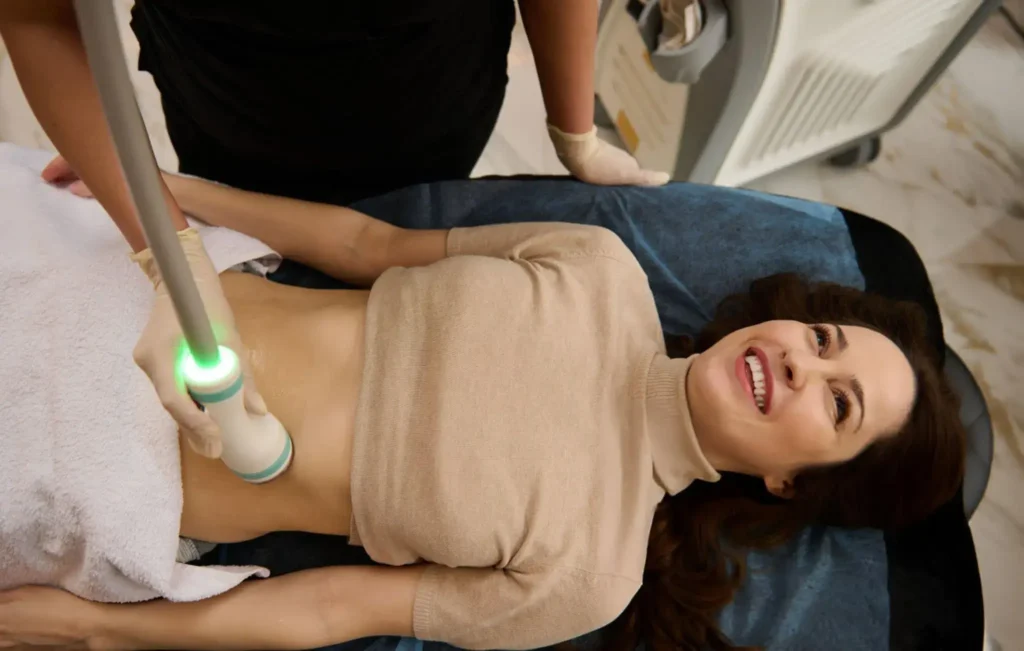Fat Freezing vs Liposuction: Which Body Sculpting Method Is Right for You?
You’ve tried diet and exercise. You’ve stuck to your fitness routine for months. Yet those stubborn fat pockets around your love handles, belly, or thighs just won’t budge. Sound familiar?
If you’re considering body contouring treatments, you’re probably weighing up two main options: fat freezing and liposuction. Both promise fat reduction, but they work in completely different ways. One requires surgery and recovery time, while the other lets you return to work the same day.
This guide breaks down everything you need to know about these fat reduction treatments. We’ll cover safety, results, downtime, and costs so you can make the right choice for your lifestyle and goals.
Understanding Fat Freezing: The Non-Surgical Option
Fat freezing, also known as cryolipolysis, uses controlled cooling to target and eliminate fat cells. The process freezes fat cells in specific treatment areas without damaging surrounding skin or tissue.
Here’s how it works: A specialist places a cooling device on your target area. The device draws tissue into an applicator and cools it to a precise temperature. This controlled cooling causes fat cells to crystallise and die naturally. Your body then processes and eliminates these dead fat cells over the following weeks.
The treatment takes about 35-60 minutes per area. You can read, work on your phone, or simply relax during the session. Most people describe the sensation as cold initially, followed by numbness as the area becomes numb.
Who Makes a Good Candidate for Fat Freezing?
Fat freezing works best for people who:
- Are close to their ideal weight
- Have pinchable fat in specific areas
- Want to avoid surgical procedures
- Cannot take time off for recovery
- Prefer gradual, natural-looking results
This treatment targets areas like love handles, belly fat, thigh fat, and double chins. It’s particularly popular with busy professionals and parents who need to maintain their daily routines.
Also Read: https://skinduced.com.au/fat-freezing-side-effects
Understanding Liposuction: The Surgical Approach
Liposuction is a surgical procedure that removes fat through small incisions. A surgeon inserts a thin tube called a cannula into the treatment area and uses suction to remove fat cells directly.
The procedure typically takes 1-3 hours, depending on how many areas are being treated. You’ll need general anaesthesia or heavy sedation. Recovery involves wearing compression garments, managing swelling, and taking time off work.
Results appear immediately after surgery, though swelling can mask the outcome for several weeks. The surgeon removes significant amounts of fat in one session, making it suitable for larger fat deposits.
Who Makes a Good Candidate for Liposuction?
Liposuction may suit people who:
- Have larger amounts of fat to remove
- Want immediate, dramatic results
- Can take 1-2 weeks off work
- Are comfortable with surgical procedures
- Have good skin elasticity
This surgical procedure works on multiple areas of the body, including the abdomen, thighs, arms, and back.
Fat Freezing vs Liposuction: Side-by-Side Comparison
| Factor | Fat Freezing | Liposuction |
| Procedure Type | Non-surgical | Surgical |
| Downtime | None – return to work same day | 1-2 weeks off work |
| Anaesthesia | None required | General anaesthesia needed |
| Results Timeline | Gradual over 2-3 months | Immediate (with swelling) |
| Fat Reduction | 20-25% per treatment | Up to 5 litres removed |
| Treatment Sessions | 1-3 sessions per area | Single procedure |
| Recovery | Minimal discomfort | Pain, swelling, bruising |
| Scarring | No scars | Small incision scars |
| Cost | Lower upfront cost | Higher surgical fees |
Safety Comparison: Which Treatment Has Fewer Risks?
Fat Freezing Safety Profile:
- No surgery means no surgical risks
- Temporary side effects include redness, swelling, and numbness
- Rare complications include paradoxical adipose hyperplasia (fat cells growing larger)
- TGA-approved treatment with extensive safety data
- No anaesthesia risks
Liposuction Safety Profile:
- Surgical risks include infection, bleeding, and anaesthesia complications
- Potential for uneven results or dimpling
- Risk of fluid accumulation or fat embolism
- Requires a skilled surgeon and a proper facility
- Recovery complications possible
For most people seeking body contouring, fat freezing presents a safer option with fewer potential complications.
Results: What Should You Expect?
Fat Freezing Results: You’ll start noticing changes around 3-4 weeks after treatment. The most dramatic results appear between 8-12 weeks as your body naturally eliminates the dead fat cells. Many people see a 20-25% reduction in fat thickness in treated areas.
The results look natural because the fat reduction happens gradually. Your clothes fit better, and the treated areas appear more contoured. Multiple treatments may be needed for optimal results.
Liposuction Results: You’ll see immediate changes after surgery, though swelling obscures the final result initially. Once swelling subsides (usually 3-6 months), you’ll see the full outcome. Liposuction can remove larger amounts of fat in one session.
The results are more dramatic and immediate compared to fat freezing. However, the recovery process means you won’t enjoy your new shape right away.
Downtime and Recovery: Which Fits Your Lifestyle?
Fat Freezing Recovery:
- Return to work immediately
- Exercise the same day if desired
- Temporary numbness in the treated area
- Mild discomfort for 1-2 weeks
- No special clothing required
- No activity restrictions
Liposuction Recovery:
- 1-2 weeks off work minimum
- 4-6 weeks before full activity
- Compression garments for several weeks
- Pain medication required
- Swelling and bruising for weeks
- Follow-up appointments needed
If you’re a busy professional, parent, or cannot take extended time off, fat freezing offers a clear advantage.
Cost Considerations
Fat freezing typically costs less upfront per session, but you might need multiple treatments. The total investment depends on your goals and the number of areas treated.
Liposuction has higher upfront costs due to surgeon fees, facility costs, and anaesthesia. However, it’s usually a one-time procedure.
Consider not just the treatment cost, but also time off work, childcare arrangements, and recovery expenses when making your decision.
Need help deciding which treatment suits you?
Our Newcastle clinic offers expert-guided fat freezing sessions no pressure, just personalised advice.
Making Your Decision: Key Factors to Consider
Choose fat freezing if you:
- Want to avoid surgery
- Cannot take time off work
- Prefer gradual, natural results
- Have smaller fat deposits
- Value safety and minimal risk
- Want to maintain your routine
Consider liposuction if you:
- Have larger amounts of fat to remove
- Want immediate, dramatic results
- Can take an extended recovery time
- Are comfortable with surgical procedures
- Have realistic expectations about recovery
The Bottom Line
Both fat freezing and liposuction can help you achieve your body contouring goals, but they suit different lifestyles and preferences.
Fat freezing offers a non-invasive approach with no downtime, making it ideal for busy people who want effective fat reduction without disrupting their lives. The controlled cooling process naturally eliminates fat cells safely and gradually.
Liposuction provides more dramatic, immediate results but requires surgery, anaesthesia, and significant recovery time. It’s better suited for people who can take time off and want to remove larger amounts of fat.
The best choice depends on your goals, lifestyle, and comfort level with different procedures. Consider your work schedule, family commitments, and personal preferences when making this decision.
Many people find that fat freezing treatments provide the results they want without the risks and downtime of surgery. The gradual fat reduction looks natural and fits seamlessly into busy lifestyles.
Ready to Take the Next Step?
Still deciding between fat freezing and liposuction?
At Skinduced Aesthetics in Newcastle, we offer TGA-approved fat freezing treatments with no surgery, no downtime, and proven results.
Our qualified team will assess your goals during a free consultation and help you choose the safest option for your body. We’ll explain how controlled cooling works, show you before and after photos, and answer all your questions without any pressure.
Whether you are targeting love handles, belly fat, or other stubborn areas, we’ll create a treatment plan that fits your lifestyle and goals.
Book a free consultation today with our qualified team. We’ll assess your goals and help you choose the safest option for your body.
👉 Book Your Free Consultation Now
Transform your body confidence with safe, effective fat freezing treatments. No surgery required, no downtime needed — just real results that fit your life.
Common Questions About Fat Freezing vs Liposuction
Does fat freezing hurt?
Most people experience cold sensations initially, followed by numbness. The treatment is generally comfortable enough that you can read or work during the session.
How long do results last?
Both treatments provide permanent fat reduction. The treated fat cells are eliminated from your body. However, remaining fat cells can still expand if you gain weight.
Can I combine treatments?
Some people choose fat freezing first, then consider liposuction later for additional areas. Discuss your goals with a qualified practitioner.
Which treatment works faster?
Liposuction provides immediate results, while fat freezing takes 2-3 months to show full results. Consider whether you prefer quick, dramatic change or gradual, natural improvement.
Are the results natural-looking?
Fat freezing provides very natural-looking results because fat reduction happens gradually. Liposuction results can look more dramatic and may require a skilled technique for a natural appearance.
What happens to the skin after fat reduction?
Both treatments can cause some skin tightening. However, if you have significant loose skin, you may need additional treatments regardless of which fat reduction method you choose.



